|
|
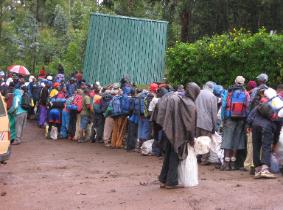 |
|
|
Climbing Mt. Kilimanjaro is like being on a roller coaster, and I’m
not talking about the steep terrain. It is a roller coaster of emotion
from start to finish. In the weeks leading up to the climb—well, heck,
since we booked the climb months and months ago—Jarrod and I
have looked at July 18th-July 25th with lots of anticipation and a bit
of dread. There is nothing we like better than heading into the
great outdoors for a good hike. But, the thing is, we always return
home at the end of the day to our warm, soft bed. I have personally
never been camping before, and Jarrod’s camping experience is
limited at best. So what were we thinking when we decided to
spend seven days and six nights sleeping on the side of a mountain
as we climbed to the highest point on the African continent?
I’ll end the suspense quickly and come right out and say, we
couldn’t have made a better decision than to climb Mt. Kilimanjaro.
That week has made an indelible impression on both our hearts and
left us with a multitude of memories that we will enjoy reliving well
into our ripe old age…from the friendships we built with our guide
and porters to the astonishing scenery to the physical challenge of
summit day.
You are required to hire a guide to climb Mt. Kilimanjaro,
independent climbing is not allowed. Florent, our guide through Roy
Safaris, picked us up from our hotel in Arusha, Tanzania on the first
morning of our climb. Also in the car was Abdi, who would be our
cook for the next week, and Emmanuel, who would be one of our
porters. We were told seven porters would be needed for our
group. We had a hard time believing this was necessary, as our
group consisted of only Jarrod and me. However, when you stop
and think about it, between food for three meals a day for seven
days, cooking equipment, propane, our tents, our guide’s tent, our
trekking equipment, the water containers, and the trash that must
be packed out, it starts to make more sense. When we arrived at
the Machame gate (Machame is the route we chose to climb. There
are several routes up Kilimanjaro, each varying in length and
difficulty) we saw a chaotic scene of people crowded in the parking
lot. We learned that men from local villages come to the gate every
morning in hopes of being selected as a porter. Each guide
determines how many porters he will need for his group and who
they will be. For roughly $4-8 US dollars a day, these men haul up
to 50 pounds of equipment and supplies up the mountain on their
head and back, and are also in charge of finding a campsite,
pitching the tents, preparing meals, and packing everything up the
next day. Again, all for $4-8 US dollars a day. And being a porter is
considered a good job in Tanzania. This is definitely food for
thought…
|
|
|
|
|
|
|
The crowd of men from local villages at the
Machame gate, hoping to be selected as porters
|
|
|
|
|
|
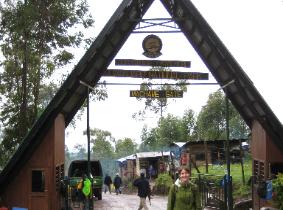 |
|
|
|
|
|
The Machame Gate, the start of our Kilimanjaro
climb. Also, the last time you'll see Erin with
clean hair for seven days
|
|
|
|
|
|
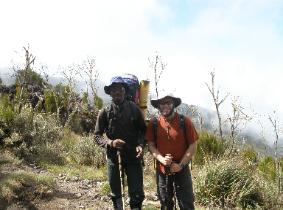 |
|
|
|
|
|
Jarrod on the trail with Florent, our guide from
Roy Safaris.
|
|
|
|
|
|
After checking our gear one last time and putting on our gaiters, we left behind the world of showers, toilets and
beds and headed into the tropical forest for our first day of hiking. Our first three days would consist of 5-7 hours of
hiking. This meant a wake-up call at 7:00am where one of the porters, Emmanuel, would deliver two bowls of hot
water outside our tent for washing and brushing our teeth. Then we would get dressed, pack our sleeping bag and
thermarest back in our rucksacks, and bring our empty water bottles to breakfast at 7:30am. Our meals took place in
a small section of the porter’s tent. There was a little table and two stools set up inside. You wouldn’t believe the
amount of food served on this hike. Breakfast typically started off with a big bowl of steaming porridge served with a
plate of fruit—usually mango, papaya and bananas. Then, out would come a huge platter of sausage, eggs and toast.
Alongside that, our selection of hot drinks included tea, coffee, and hot chocolate. There was more to choose from
here than we usually had at home! Lunch was the least exciting meal of the day, as it was a boxed lunch we took
with us and ate en route. But we’re not complaining—there we were on side of a mountain, miles away from the
nearest source of electricity, and we’re having three complete meals a day prepared for us. This camping ain’t so bad
folks! In our lunch box we would typically find some type of sandwich, a meat and onion pie, a banana, a piece of
pound cake, an orange and a hard boiled egg. After reaching our next campsite, Jarrod and I would crawl into our
tent, which had already been pitched for us, and change out of our hiking boots. Again, two bowls of hot water would
be brought to us for washing by Emmanuel. After washing up we would have a few hours of daylight in which we
|
|
|
|
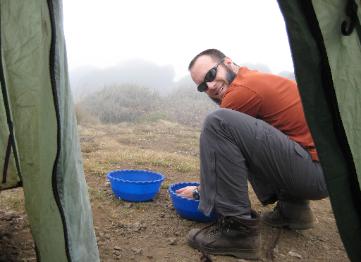 |
|
 |
|
|
|
This is what a shower consists of on the side of a mountain.
|
|
Home sweet home on Kili.
|
|
|
|
|
|
could write in our journals, take pictures of the campsite or chat with fellow hikers. All in all we probably made our
way up the mountain along with 75 other hikers. As there is only one designated campsite at each stage of the hike,
we would all be spread out in the same area. This may sound overwhelming and counterproductive to the why most
people go on hikes (to enjoy the peace and solitude of nature), but we found that we really enjoyed it. We met
people from all walks of life. There was a man from Jordan who was attempting to be the first Jordanian to climb the
world’s seven tallest peaks. He had completed all but Kili and Everest. Actually, he had attempted Everest twice, but
had to turn back before reaching the summit due to a bleeding ulcer one time and an injured ankle the next. I’m sure
Mt. Kilimanjaro, being a non-technical climb, was a walk in the park for him! He is making his next attempt on Everest
in the fall of ‘07, so check out his website at www.jordanfirsteverest.com to see if he makes it. We wish him the best
of luck. We also met a father and son from Colorado who are regular competitors in summit races. This is when you
see how fast you can make it up and back down a mountain. Last, there was a married couple from New York who
participate in adventure races on a regular basis. After running into this handful of people, Jarrod and I began to
seriously wonder what in the heck we were doing attempting this climb. Eventually we met fellow “weekend warriors”
as well, and enjoyed trading stories of how crazy it was to be experiencing a challenge of this magnitude. After
enjoying a few hours of daylight at our campsite we would be called to dinner. Dinner was quite an impressive meal
considering it was cooked over a small propane stove. We always started out with some kind of soup—eggplant,
celery, or mushroom, followed by a vegetable stew served with mashed potatoes or rice, and then some sort of meat
would follow, from fish sticks to chicken. Dessert was typically fruit, although one time Abdi did surprise us with a plate
of fried bananas decorated with our names written in mayonnaise (it was more the thought than the actual gourmet-
ness of the creation). If we did not make it to the summit it certainly would not be due to malnutrition. By the time we
finished our three course dinner daylight was a thing of the past, and the only thing to do was crawl into our tent,
don our headlamps and read or write in our journal.
|
|
|
|
By the third day we were in a rhythm. It literally felt like our job on this earth was to hike, eat and sleep, and then
wake up the next day and do it all over again. Amazingly we did not experience any soreness or lethargy from hiking.
All in all, the difficulty level of the first five days was not all that high, the challenge lay more in dealing with the
elements (altitude, sleeping on the ground, being dirty, and trying to keep warm). For the first two days Jarrod and I
experienced a growing sense of confidence that we would make it to the summit. We ended each day with a sense of
exhilaration about our experience. Seeing the world from above the clouds while on foot, and not in an airplane,
provides a profound sense of serenity and also exhiliration. More than anything we were struck by the sheer beauty
of nature, and how fortunate we were to see this corner of God’s creation. Looking out at the blanket of cottony
clouds, the only thing breaking through this endless plain was the far away peak of Mt. Meru, Tanzania’s second most
climbed mountain. By Day 3 of our hike we were just about equal to Meru’s summit of 14, 979 feet, yet we were only
halfway to Kili’s summit. This put into perspective how high we would eventually be. But Day 3 introduced us to the
|
|
|
|
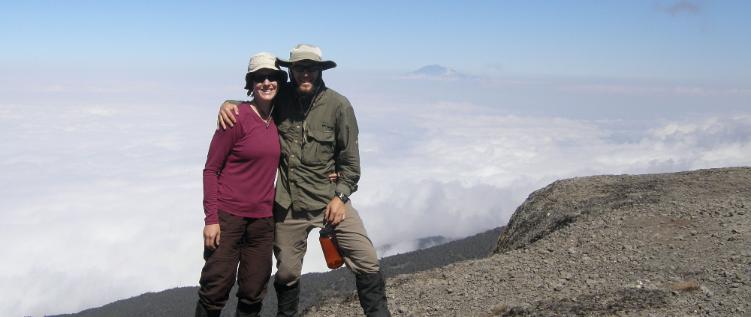 |
|
|
|
Erin and Jarrod on top of the Baranco Wall en route to Kili's summit. Mt. Meru can be seen peeking through the clouds.
|
|
|
|
wonderful world of altitude funk. At this point I call it altitude funk, and not altitude sickness, because it was just an
overall feeling of tiredness. Suddenly, walking up a slight incline or stepping over a series of rocks left me breathless
and with my heart racing. In addition to that, Jarrod and I both started to feel a bit dizzy and had to rely on our hiking
poles much more than we had before. Day 3 was a day of up, up, up, and then back down again. We climbed from
12,467 feet up to a huge tower formed by lava at 15,091 feet. We stopped here to have lunch, and Jarrod and I both
suddenly found ourselves without an appetite (one of the signs of altitude funk). We knew that we had to eat, and
thus began the first of four days of force feeding ourselves. I don’t think we said more than two words to each other
during that lunch, we just stared off into thin air (literally, thin air) and wondered if it would all be downhill from here.
Would our altitude funk soon turn into full-fledged altitude sickness, complete with pounding headaches, raging
nausea, shortness of breath and the inability to sleep or eat? If so, the next four days were not going to be much fun.
The second half of Day 3’s hike was all downhill, leading us to our campsite at 12,795 feet. By climbing high and
sleeping low the body is exposed to high altitude, forced to acclimate, and then given the chance to rest and recover
at a lower level. This way, when we made our way back to the higher altitude the next day, our body would have an
easier time adjusting to the elements. And by golly, you know what…it worked! We went to bed on Day 3 with a
headache and the overall sluggishness I mentioned before, and both woke feeling 100%.
|
|
|
|
continue >
|
|
|
|
|
|
|
|

